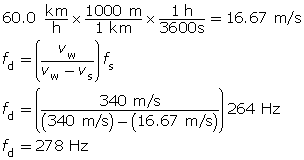Module 8—Mechanical Waves
The Doppler Equation
If a sound source is moving towards you (the observer), the wavelength is compressed a distance equal to the amount of distance the source moves during the time it takes to produce one full wave. Considering this fact, and using previous definitions for uniform motion (v = d/t) and period (T = 1/f), the Doppler effect can be described as the following equation:

| Quantity | Symbol |
SI Unit |
Doppler frequency (observed) |
fd |
Hz |
source frequency |
fs |
Hz |
wave velocity |
vw |
m/s |
source velocity |
vs |
m/s |
When the source is moving towards the stationary observer, the equation produces a higher observed frequency than the source frequency. The equation is as follows:

When the source is moving away from the stationary observers, the equation produces a lower observed frequency than the source frequency. The equation is as follows:

 Read
Read
How is this formula applied? Read “Analysis of the Doppler Effect” starting from the bottom of page 430 to the bottom of page 432 of your textbook.
 Self-Check
Self-Check
SC 1. Complete question 1 of “Practice Problems” on page 432 of your textbook.
 Self-Check Answers
Self-Check Answers
SC 1.
Given
fs = 264 Hz
vs = 60.0 km/h
vw = 340 m/s
Required
the apparent frequency of the horn (fd)
Analysis and Solution
Convert the speed of the vehicle to m/s. Use the form of the Doppler effect equation for an approaching vehicle.

Paraphrase
The apparent frequency of the horn is 278 Hz.
 Module 8: Lesson 6 Assignment
Module 8: Lesson 6 Assignment
Remember to submit the answers to TR 4, TR 5, and TR 6 to your teacher as part of your Module 8: Lesson 6 Assignment.
 Try This
Try This
TR 4. A fire engine is being driven away from you at a speed of 15.4 m/s. One of the notes in its siren sequence has a fundamental frequency of 244 Hz. If the speed of sound is 338 m/s, what will seem to you to be the fundamental frequency of that particular note?
TR 5. An automobile is approaching you at a speed of 50.0 km/h and sounding its horn. The fundamental frequency of the horn sounds to you like 266 Hz. If the speed of sound is 335 m/s, what is the real fundamental frequency of the horn?
TR 6. An automobile is approaching you at a speed of 90.0 km/h and sounding its horn. The fundamental frequency of the horn sounds to you like 268 Hz. If the real fundamental frequency of the horn is 248 Hz, what is the speed of sound?